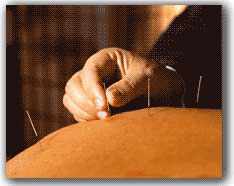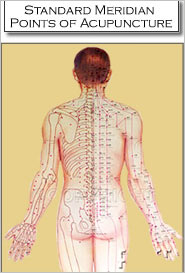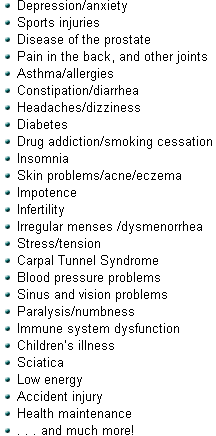

What is Acupuncture?
 Acupuncture is a comples branch of ancient Chinese medicine, but its practical principles and methods are easily understood:
Acupuncture is a comples branch of ancient Chinese medicine, but its practical principles and methods are easily understood:
1. Fourteen major energy channels called meridians course through the human body including the head, arms, hands, legs, feet, torso, and internal organs.
2. A subtle energy called Chi (pronounced chee) circulates via the meridians to all parts of the body, even the most remote cells.
3. Chi is the vital force, the presence of which separates the living from the dead. It's balanced, unimpeded flow is critical to sound health.
4. Any misdirection, blockage, or other derangement of the amount, flow, or balance of Chi may result in pain, dysfunction, and ill health.
5. With acupuncture needles, or other means, the acupuncturist stimulates certain points (acupoints) along the course of the meridians. Such stimulation helps restore the normal balance and flow of Chi so organs and bodily systems can work together in harmony as intended. This sets the stage for the body to repair itself and maintain its own health.

Meridians? What are they?
 Several thousands years ago Chinese physicians discovered that Chi, the vital force, circulates throughout the body along fourteen major channels, twelve of which are
Several thousands years ago Chinese physicians discovered that Chi, the vital force, circulates throughout the body along fourteen major channels, twelve of which are
duplicated on the left and right sides of the body.
The two other major channels are located in the center of the body, one in the front, the other in the back. And there are a number of so-called Extra Channels and Miscellaneous Channels throughout the body. Today, English-speaking acupuncturists usually call the channels "meridians".
Meridians from a highly-complex invisible network transporting and directing Chi to every
part of the body including the head, arms, legs, torso, organs and systems. Good health Chineses sages of old discovered, depends on a balanced circulation of Chi throughout the meridians.
Over centuries of trial and error and metculous observation, the Chinese accurately mapped the locations of the meridians and identified hundreds of specific points in the meridians
where Chi can be accessed and stimulated when there is an aberration of flow.
Those points are commonly called "acupoints." Over time, many more points have been discovered.

Chi? What is it? What does it do?
One English translation of the word Chi means energy, and though Chi is invisible, its presence becomes especially apparent in the workings of the bodily organs and systems which require prodigious amount of energy. Yet the Chinese view Chi not only as powering a function as though there's no Chi without function and
no function without Chi.
Chi is also known as the life force, and since the total absence of Chi id death, obviously one's good health depends on a balanced distribution of Chi throughout the meridian network that influences the organs as well as the bodily system: skeletal, muscular, endocrine (glands), circulatory, digestive, respiratory, urinary, reproductive, and nervous. When Chi flows smoothly and harmoniously
throughout the meridians, each bodily system and organ interacts with and affects all the other systems and organs, which in turn are interdependent, interrelated, and integrated. Everything works together to make us feel whole and healthy, thanks to Chi.

What conditions are treatable by acupunture?
In Chinese medicine's terms, acupuncturists treat an imbalance of Chi, but in Western terms they treat hundreds of symptoms and conditions with positive results, among conditions with positive results. Among conditions most frequently treated are the following:


What are the main objective of acupuncture treatment?
The main objective are three:
1. Relieve pain and other symptoms
2. Strengthen the immune system
3. Balance, harmonize, and integrate functions of the organs with each other, making for a unified, healthy person, rather than a collection of fragmented, disharmonious parts
